SEGA DREAMCAST AREA HISTORY FEATURE
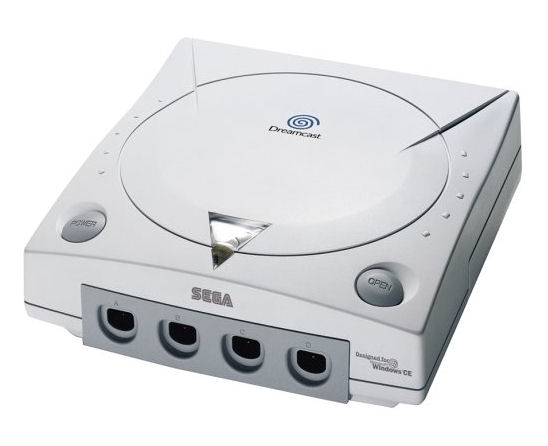
"Dreamcast will take you to a brand new world. It's not just a TV-game but a whole lot more. A new level of entertainment awaits you." - Japanese Box (HKT-5010)
After success in Japan only with the Saturn and its near zero impact in the Western markets, SEGA armed with a new team of chief executives decide on a final attempt making their name reside in the notoriously difficult hardware market of console gaming.
SEGA by this time had lost vast amounts of money. The Saturn had pushed SEGA way into the red. $500 million was allocated to the designing, creating and marketing the console.
Any mistakes would have dire consequences for the company as a whole. All this was known at the start but SEGA was dead-serious about this venture.
The Dreamcast was to be everything the Saturn was not and would leave the existing Playstation and N64 standing in every department. SEGA re-entered the console wars with a fresh new approach, a new console and the most original and intuitive games ever created as well as the first Internet-enabled console.
Unfortunately, SEGA's debts (incurred in the previous dreadful generation) became too great for them to sustain the system. Crushed by consoles that were backed with more cash, it is the tragic story of the death of the dream that started out with such promise.
Inception
Work for the successor of the Saturn began in 1997. Two were actually designed. There was also a third and very secretive project with Nvidia (whom were still a relatively new company at the time) based on the NV2 chipset but this was abandoned in the early stages.
Being sure to avoid some of the biggest makes made with the Saturn's hardware, SEGA wanted a much more simplistic design made with 'off-the-shelf' components to reduce manufacturing costs. To that end, SEGA approached two of the biggest video chip makers of the day: NEC/VideoLogic and 3DFX Interactive. Both had chipsets making an impressive impact on the PC platform pushing new standards in 3D graphics.
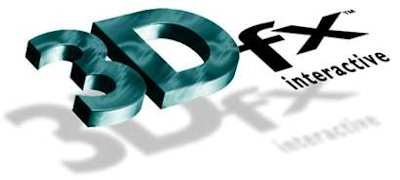 3DFX Interactive (Circa 1999) |
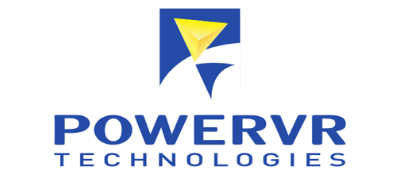 PowerVR |
Two projects were initiated under two different codenames and developed independently. SEGA would have the choice of the better system.
The NEC/VideoLogic work was done in Japan under the names "Dural" / "White Belt" (Dural being the liquid metal character from Virtua Fighter) with long-time collaborators Hitachi supplying the main CPU - the SH-4, with a the PowerVR2 GPU.
The 3DFX Interactive work was done in the US under the name "Black Belt" and used an IBM/Motorola PowerPC 603e CPU and the GPU was based around the Voodoo 2 chipset.
Ultimately, the decision was to go with NEC's/VideoLogic's (Japanese) design which resulted in a legal fallout between SEGA and 3DFX (whom settled out of court) but the systems codename was now officially 'Katana'.
However, there was no DVD-ROM in the specification. Only a handful of games across all platforms at the time required the storage capabilities of DVD-ROM and the earliest players were just hitting the shops. The technology was simply too expensive. SEGA instead would have their own preparatory storage - Gigabyte Digital Read Only Memory (GD-ROM) that allowed up to 1GB on a single disc and maintain backwards compatibility with CD's for Audio and CD+G etc.
When 'Katana' was unveiled its specifications were more powerful than SEGA's Model 3 arcade board which had been drawing audiences in the arcades with games such as Virtua Fighter 3 and The Lost World: Jurassic Park. It was a great success in terms of development cost saving having learned their lesson from the costly production of the complex multi-processor Saturn chipset.
Another key component (and a harsh lesson from the Saturn era) was a much easier development environment essential for plentiful third-party support. SEGA provided their own low-level libraries to get the best performance and partnered with Microsoft to make its Windows CE operating system available in order to woo potential developers with PC games running on Windows 95/98. If this looked like a trojan horse operation then it probably was.
For the gamer, a main emphasis was to give the world an Internet-enabled console 'out-of-the-box' and as many online games as possible. Having already pioneered this with Netlink on the Saturn and seeing the rise of online gaming on the PC, SEGA deemed this would be the next feature required in consoles and so their machine would be able to capture this growing market. Systems were to ship with a modem and online portals would provide information, email accounts, downloads and forums amongst other services.
Finally, a name was needed. SEGA knowing their name had weakened (particularly in the West) a moniker that represented a new beginning was needed. Management concluded removing the SEGA name and essentially create a new gaming brand. Up to 5000 names were considered before 'Dreamcast' was settled upon as it hinted at the massively expanded connectivity the console was to provide. The SEGA logo would get to be on the console in a subdued fashion.
On the 21st May 1998 the Dreamcast console was shown to the world for the first time at a press event, 'The SEGA New Challenge Conference' and was scheduled for launch by the end of the year.
The early death of the Saturn had given SEGA some time and resources to hit the ground-running with content for this next system. Examples include, Yuji Naka whom had started on a brand-new 3D Sonic game which the Saturn painfully lacked to a damaging degree and Yu Suzuki had pulled his highly ambitious project Shenmue from the Saturn to the Dreamcast which offered far more power.
With attractive hardware, some of the largest third-party developers signed up including Capcom (whom had stuck with the Saturn to the bitter end), Namco and Midway – all arcade companies that would bolster the systems standing as an arcade experience. EA did not want anything to do with the system as they wanted exclusivity in making sports titles. This was not possible as SEGA has just bought a studio specifically to create those titles. Others adopted a wait-and-see approach based on sales.
As with SEGA tradition, an arcade version of the system was produced called New Arcade Operation Machine Idea (NAOMI). It was positioned as low-cost upgrade path from SEGAs Model 3 arcade hardware and made it their flagship board.
Regional Histories in Brief
Japan
Launched: 27th November 1998. Available Titles (4): Godzilla Generations, July, Pen Pen Tricelon, Virtua Fighter 3tb.
The arrival of the Dreamcast had been considered somewhat premature to Japanese developers and publishers as the Saturn had been so successful and continued to be so. There did not seem to be a need for another console at the time. SEGA had intended for the Saturn to continue supplying 2D games whilst the Dreamcast would supply the 3D games. Still, there had been a strong take up in pre-orders which denoted high consumer interest. There were to be 500,000 units available for launch but pre-orders had to be halted at 80,000 only a few days after opening reason being manufacturing problems at NEC with the PowerVR2 chip– a somewhat shocking announcement from one of Japans biggest electronics companies.
The SEGA Dreamcast was released priced 29,000 yen. Like many Japanese launches, it was subdued with the small number of consoles and the titles available that showcased the new system lacked quality.
150,000 consoles were available. 80,000 were reserved for the pre-orders and the rest shipped to retailers. All sold out on the first day. This also meant that the system had sold out before it had effectively launched. Shortages continued through to Christmas.
 Side A |
 Side B |
SoJ had a clever self-deprecating advertising campaign which saw real-life SEGA MD Yukawa Hidekazu getting into all manner of unpleasant situations as he grappled to make the console successful. The brief adverts (30 seconds) showed that SEGA had a sense of humour and willing to show they had made mistakes in the past emphasising that the Dreamcast represented a new start. They proved a hit with Japanese audience and made Hidekazu a star. He along with president Shoichiro Irimajiri was outside on the high street in Akihabara – the gaming hub of Tokyo - selling consoles.
Unfortunately, the plan for frequent new releases did not play out. Some high-profile games were delayed or even cancelled. Sonic Adventure and SEGA Rally Championship 2 planned for launch suffered production delays along with the highly anticipated Resident Evil: Code Veronica becoming delayed by a several months.
The modem offered access to the Dricas service intended for Internet access for the Dreamcast in Japan. The accompanying web browser – Dream Passport, added the ability to send images and videos through e-mail and video chat via the Dreameye accessory. Other benefits to Dricas were an online portal designed to allow Dreamcast owners to communicate, earn loyalty points and even see on a primitive map where other gamers were located. All very advanced for the day.
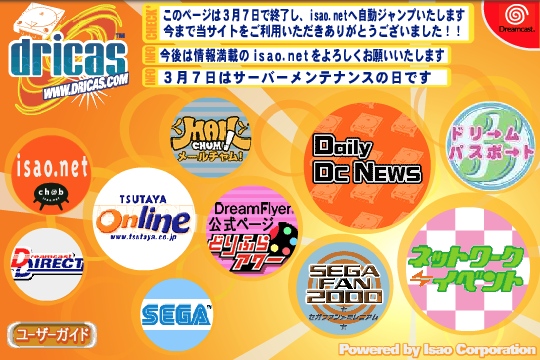
Dricas
The anticipated Sonic Adventure was released December 23rd and it delivered giving a boost in sales prior to Christmas and more players than expected were using the services granted by Dricas/Dream Passport.
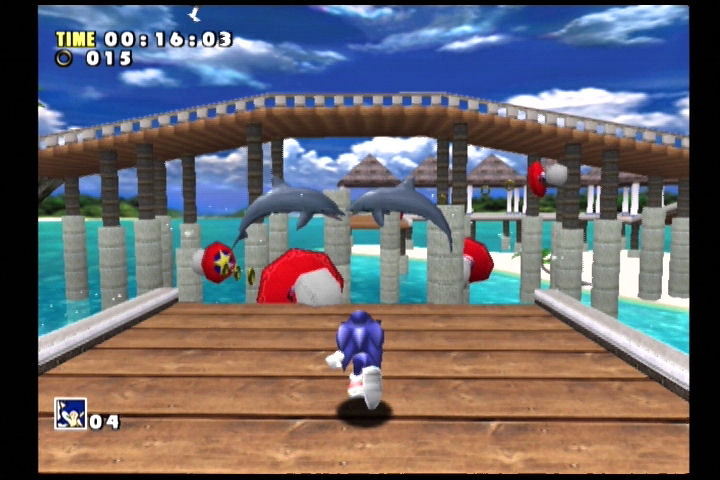
Sonic Adventure
1999
SEGA predicted that the PS2 would arrive sometime towards the end of the year so set about recruiting as many more third-party developers as they could.
New releases were infrequent for almost the first 6 months. Some key software titles such as Power Stone, a high-profile 3D brawler from Capcom, although was a fantastic game for some reason failed to sell in the numbers expected.
SEGA began to panic prior to the upcoming Western launches and at the New Challenge Conference 1999 the price of the console was dropped to 19,900 yen and early titles reduced to 1,900 yen. Whilst good for gamers this removed all profit from hardware sales. It resulted in a surge in sales, but this may have been propelled release of the stunning Soul Calibur - a highly anticipated combat game from Namco and delivered arcade perfect to the home.
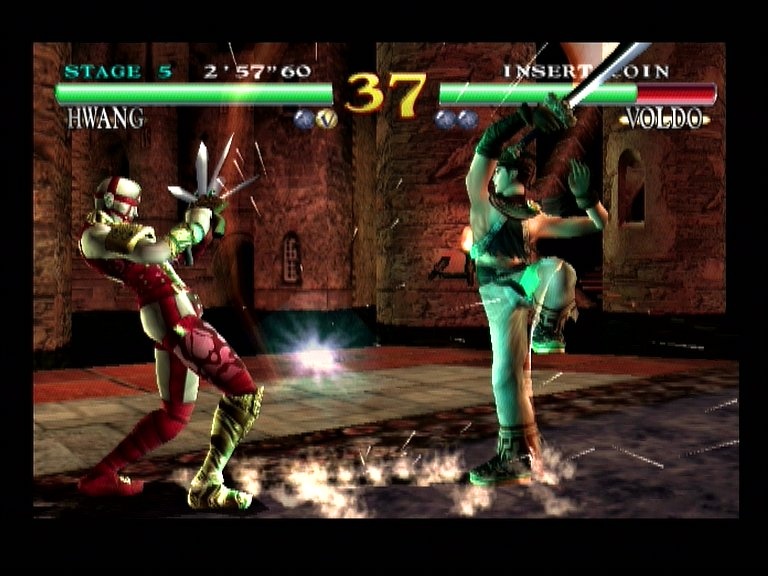
Soul Calibur
By now it had become less viable to keep the Saturn alive and as such the last releases would arrive.
2000
The start of the year saw a change in top management in Japan that would also recurse to the North America. The sales spike ended and sales returned to their sluggish pace.
It was not until a few months later with the release of Seaman that utilised the microphone accessory that the console got its first exclusive mega-hit.
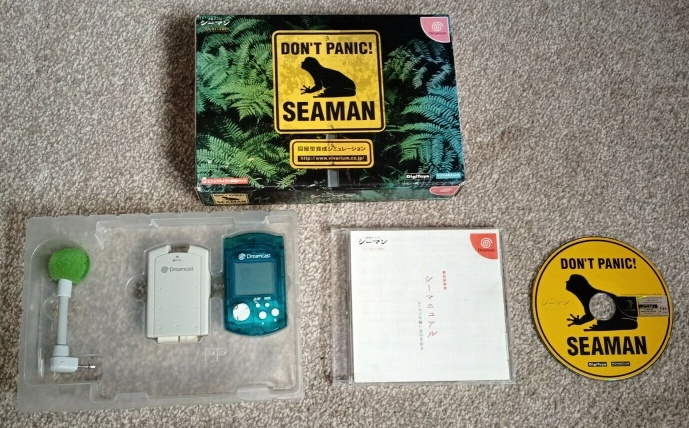
Seaman Special Package
By June, 2.1 million consoles had sold and SEGA was making a 2,000 yen loss on every console, but this figure had already been overtaken by the PS2 launched in March which managed 1 million units in its opening weekend alone.
As an aside, the very last Saturn title was released December 7th entitled Yuukyuu Gensoukyoku: Perpetual Collection some two years after the launch of the Dreamcast.
2001 - The End
Ultimately, the Dreamcast achieved minor success in Japan and SEGA's final game for the console was Puyo Pop Fever in 2004. Releases continued and the last title was Karous in 2007 released in GD-ROM format as SEGA were phasing out their use on NAOMI also.
SEGA considered Japan a key territory and like the Saturn got many exclusive games, peripherals and even special models of the console. Perhaps this was another mistake.
North America
Launched: September 9th 1999. Titles Available (19): AeroWings, Airforce Delta, Blue Stinger, Flag To Flag, Hydro Thunder, Millennium Soldier: Expendable, Monaco Grand Prix, Mortal Kombat Gold, NFL 2K (SEGA Sports), NFL Blitz 2000, Pen Pen TriIcelon, Power Stone, Ready 2 Rumble Boxing, Sonic Adventure, Soul Calibur, TNN Motorsports Hardcore Heat, Tokyo Xtreme Racer, Trick Style, The House of The Dead 2.
Both Western launches were purposely delayed to ensure a much stronger launch line-up. It would be the first time a SEGA console would launch with enough games to cover almost every genre of gaming.
SoA kept any details of the launch secret for as long as possible perhaps not to draw attention to the otherwise dull performance seen in Japan in the first six months.
Mid 1999, a vague marketing campaign began with "it's thinking" and the consoles logo and launch date were now known but there was no sign of the hardware itself. There was no indication that SEGA were responsible unless you were a gamer following gaming news. This was likely intentional to distance the Dreamcast was the otherwise disastrous Saturn performance. Even so, some 300,000 pre-orders had been taken in the months prior to launch.
The delay between the Japanese and American launches allowed an enriched launch line-up. Blue Stinger and Sonic Adventure (dubbed Sonic Adventure International) were improved and utter shite like the widely derided Godzilla Generations were nowhere to be seen.
The date 9.9.99 came and forever remembered by SEGA fans and changed console launches forever.
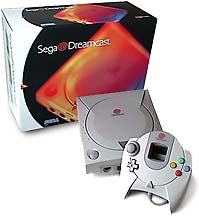
Dreamcast US Console
With an extensive marketing campaign costing some $100 million the console enjoyed a huge launch that broke any existing records. Hundreds of retailers took part in special launch parties, many opening at 00:00 with queues of eager customers waiting outside for hours. SEGA sponsored the MTV Music Video Awards and some celebrates were hired for their endorsements. Limp Bizkit frontman signed six launch models to advertise SEGANet which are floating around Ebay today.
The launch titles covered several genres but the main trio was: NFL2K (overall winner), Soul Calibur and Sonic Adventure that ensured SEGA's mascot returned to his former glory. Surprisingly missing was Virtua Fighter 3tb for launch.
The modem was included as standard (at the behest of SoA's Bernie Stolar) – the first time ever for a console - a 56Kbps model which was the fastest of the day. For $200 there was also Internet out the box. PC's in comparison cost x2 possible x3 more for similar functionality.
There were some minor issues where GD-ROMs have been incorrectly manufactured resulting in some faulty copies of Blue Stinger, Ready To Rumble Boxing and Sonic Adventure but this was quickly narrowed down to a single plant and resolved.
In comparison, the North American launch was nothing short of spectacular struggling to meet demands for consoles and peripherals. 500,000 units had gone to American homes in the first two weeks netting $98 million in combined software and hardware sales. It had become the fastest selling console of all time.
SEGA bragged (on the rare occasions that it could) that it had out performed Star Wars: The Phantom Menace in its opening weekend that took approx. $65 Million.
2000
By January some 1.5 Million consoles had sold but older consoles (Playstation and N64) were still outselling.
This reached 2.5 million consoles in March giving SEGA a 20% market share. By now news of the highly successful PS2 launch in Japan was known and it had pretty much overran the Dreamcast there. It was widely reported that the main driver for the successful launch was the DVD playback capabilities as the No 1 software was “The Matrix” rather than any PS2 games.
SEGAs promising plans for Online services were talked about allot at the E3 and there was a prediction of having 6 million consoles sold by March 2001.
By June, sales slowed. Gamers were seemingly already holding back and deciding to wait for the PS2. To counter this, on the day of the announced PS2 launch date, SEGA sweetened their SEGANet deal and offered a $50 rebate that could be spent on games.
Rumours began to circulate that Wal-Mart, possibly the biggest retailer in the US, would no longer stock Dreamcast's in favour of stocking more PS2s.
The October North American launch of the PS2 was problematic for Sony hindered by supply and distribution problems. SEGA wanted to project the image that the PS2 was expensive with an inferior games line-up – which was accurate. Harking back to the SEGA of old, a small advertising campaign mocking Sony for their PS2 supply problems was put in the gaming press and apparently (I really hope this is true) was put on the side of a truck and driven around the HQ of EA – the company that refused to support the Dreamcast.
SEGA hoped gamers holding the cash for a PS2 would now rather have a DC with its superior games library and online abilities for less cost. That thought failed to resonate and the launch broke records anyway dealing a major blow to the fortunes of the DC even though SEGA reduced the price to $149.99.
Now, with another competitor on the way in the form of Microsoft it was looking very tight for the DC.
Later, SEGA also gave another promotion of a rebate of $150 (the cost of the console) if a gamer signed up to SEGANet for 2 years.
SEGA played the strengths of their creativity by restructuring the development studios into semi-autonomous studios with greater individual freedom. This became known of the most creative period in the company's history. It created a culture of individual brand identity that meant fans would get behind games made by certain creators. Titles pumped out around this time include: Skies of Arcadia, Phantasy Star Online, Samba De Amigo, Crazy Taxi, Space Channel 5, Jet Set Radio, Shenmue to name but a few.
The DC was slashed to $99 and although there were million-selling games it made the company haemorrhage money that it could simply not afford still making loss on the cost of manufacturing consoles. Nonetheless, sales surged 156% but that was not enough to siphon off a substantial share of the market.
Piracy had now become a major issue as it had been discovered games could be burnt to a CD-R, a process that many PC owners could now do, and be bootable on a stock DC. SEGA would tweak the consoles design to prevent this.
2001-2002
By the end of January, SEGA announced that it had sold 3 million consoles. But this was not to be enough. SEGA admitted defeat. This decision had infamously fallen to Peter Moore of SoA as the Japanese were already looking towards the future. 18 years in the console business ended. In those years there had only been a few years of financial prosperity.
Console production ceased in March with the last shipment being in November at the cost of $50 per machine before vanishing into history.
SEGA continued to ship their pledged support titles until mid-2002 with games such as Sonic Adventure 2 and some from a few third-parties and by that time, the Xbox and the Gamecube were on store shelves starting a new generational war with the PS2 with the Dreamcast having gone into history.
Europe
Launch Date: October 1999. Available Titles (11): Blue Stinger, Dynamite Cop, Incoming, Millennium Soldier: Expendable, Pen Pen TriIcelon, Power Stone, SEGA Bass Fishing, SEGA Rally Championship 2, Sonic Adventure, Toy Commander, Virtua Fighter 3tb.
The logo was changed to a blue swirl as not to infringe a German company whose logo was very close to the orange swirl. Since nobody really paid attention to the Saturn it worked as a way of letting people know SEGA were back. By now SEGA had been absent for almost 2 years and the Playstation had consumed 75% of the market share with some blockbuster releases. The release of the N64 had not slowed it down much and PC gaming was growing.
With the UK being the largest gaming market in Europe, SEGAs operations were there backed by a £60 million marketing campaign – a somewhat messy and wasteful one.
To start there was a rather low-key and muddled campaign starting with "Shave" and Buoy" in adverts shown in cinemas before moving to TV in September. They perhaps were intended to hark back to the Cyber Razor Cut days of old by emphasising the “lifestyle” of the Dreamcast machine and thus few games were actually shown. This somewhat backfired because the slogan of, “up to six billion players” had to be removed by order of Advertising Standards Authority (do not mess with them) because the system did yet support online play. There were no further campaigns during launch period as SoE ditched that particular marketing agency. Thankfully this did not seem to have much impact.
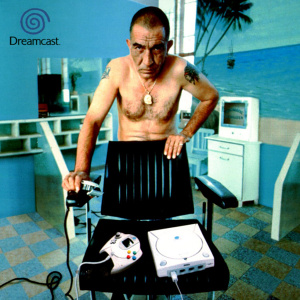
Dremcast UK Marketing - Shave
Later still, when SoE then switched advertising agency only to have that advert pulled by the ITC for potentially inciting racial hatred as it depicted European stereotypes as a way to advertise online play.
The issue to include a modem as standard had been debated for a while. After agreeing it would be, it would result in the delayed launch. It was intended the launch be simultaneous with the US on 9.9.99 but an issue with telecom giant British Telecom meant the online services would not be fully functional across Europe.
The delay of a few weeks afforded time for the gaming press to report on the news of the record-breaking North American launch, with more gamers having access to a more realised Internet and this news also flooded gaming websites generating more hype. Also, the gap between these launches saw the importing of up to 2000 foreign consoles to eager UK players.
The launch was another spectacular event. Costing £199 it was the cheapest console launch to date. A spectacle was organised hours before the midnight launch in the form of stilt walking cyber-punks (Cyber Razor Cut anyone?) and tribal drummers through Piccadilly Circus (a hub of consumerism in London) and in attendance were SEGA Top-Brass Isao Okawa, and always wanting to be on the ground, Hidekazu Yukawa and Shoichiro Irimajiri continuing a series of promotional events.
Electronic Boutique (now GAME) opened 100 of its stores at 00:00 (I attended the one in Birmingham and I can tell you it was packed. I still have my carrier bag as a souvenir) and Virgin MegaStore in the affluent and well-heeled Oxford Street in London rebranded as 'SEGAStore' for the day (a store that refused to stock Saturn's at one point) and at Tower Records in Piccadilly Circus.
It resulted in another record-breaking launch even earning a slot on the 10 O'Clock News. 100,000 consoles sold on Day One with 42,000 of those having been pre-orders. Sonic Adventure and SEGA Rally Championship 2 were the top-selling games.
Online capabilities were provided via Dreamarena and were available from day one and the system launched with the slightly slower 33.6Kbps modem.

Dreamarena
Europe benefitted much from being the last launch territory. Whilst having less titles, the quality was much better with the inclusion of the likes of Power Stone and Virtua Fighter 3tb and guaranteed weekly releases and media support by means of Official Dreamcast Magazine, DC-UK and others.
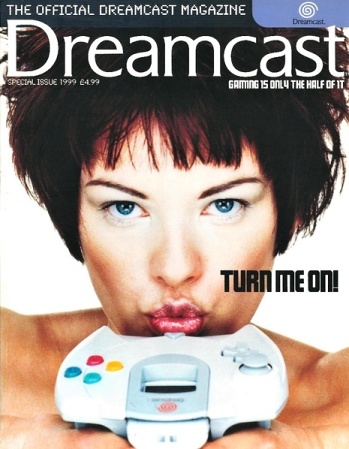
Official Dreamcast Magazine Special
By comparison, in some other European countries such as Germany sales fell short of expectations but by Christmas 500,000 consoles had shipped with SoE ahead of its own sales projections.
2000
By March 31st 1.04 Million consoles had sold. Although there was a small library of games the high quality was praised in the gaming press for all the right reasons. Unfortunately, these were not selling in the quantities necessary thought due to being all new IPs that did not attract casual gamers whom stuck to those known on the Sony's consoles instead. The DC did not host several of SEGAs staple IPs either.
New releases were regular and some were some of the jewels in the consoles library but online games were having production delays meant the online gaming revolution came too slowly. So far ChuChu Rocket! And Quake III were the only ones.
In September the price was lowered to £149.99 at the time of the PS2 launch. In an attempt to counter gamers buying the PS2 for the benefit of DVD playback – a package comprising of a Dreamcast, a superior DVD player with multi-region and MP3 playback, a copy of ChuChu Rocket! For the price of a PS2 was made but it failed to draw any attention.
2001
The European launch of the PS2 was similar to the US. Hardware shortages, inferior games library and a much higher asking price – none of these caused sales to slow. Backed by a staggering amount of third-part support (hundreds of games had been announced before launch) meant that the Dreamcast had lost the lead in just a few months.
At the end of January and the news of the console being discontinued the price was lowered to £99.99 and that lead to a surge in sales.
In April software prices for the remaining releases was capped at £29.99 with critically acclaimed cult classic Skies of Arcadia being released along with others such as Heathunter and Phantasy Star Online.
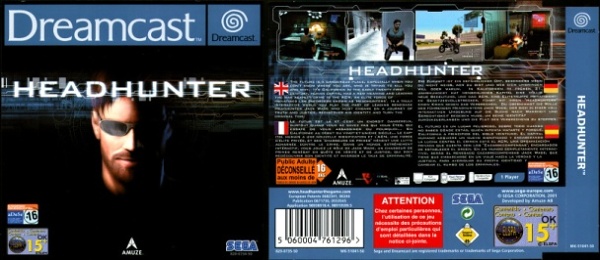
Headhunter
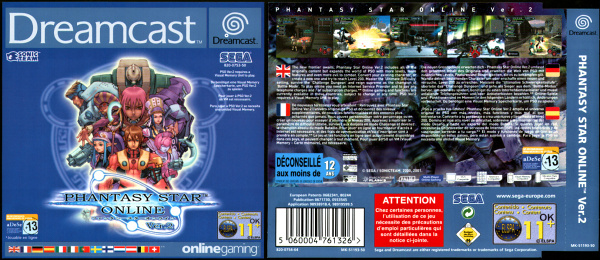
Phantasy Star Online Ver 2
2002
By June, with the release of Sonic Adventure 2, there had been 1+Million consoles sold across Europe but by this point the consoles had gone from shelves with the oddity of having a small library still available to buy. Magazines said their farewells with some touching statements.
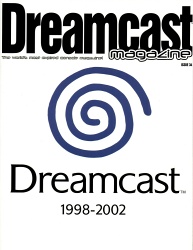 |
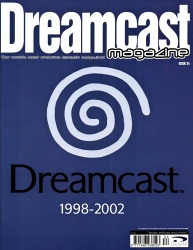 |
The last release in Europe was Razor Freestyle Scooter being released on the 5th of November 2002 from Crave Entertainment and very badly received.
Legacy
Ultimately the Dreamcast sold in excess of 10.2 million units most of them being at a loss to the company. The final piece of kit from a revolutionary company inspired a future generation therefore holding a special place in the history of gaming as being one of the most innovative.
In retrospect the Dreamcast leaves behind a massive legacy that could be a book itself of how it shaped the future of gaming. Trends of using PC components to build consoles, Internet connectivity out the box, motion-sensitive controllers and releases from independent developers are examples.
The Dreamcast solidified SEGA's life-long ambition of bringing arcade perfect into the home. SEGA had always made arcade boards from their consoles to facilitate quick ports but NAOMI was different. With it offering a relatively inexpensive upgrade from Model 3 hardware (at a time when the arcade industry was shrinking) it helped arcade owners stay open and keep costs low for developers.
NAOMI proved highly successful and arcade releases saw Dreamcast ports keeping the console active with retail releases in Japan a small import scene. Eventually, NAOMI rivalled the NEO GEO as one of the most popular arcade systems ever for both SEGA and third-parties. Some of the ported games are now coveted collector's items.
Whilst its time on store shelves was brief it was replete with memorable titles the majority of which were new IPs rather than re-hashing old games. Releases were creative and ambitious busting with colour that created a new generation of fans.
These games were defining of the time: Crazy Taxi, Jet Set Radio and Shenmue (which has just seen another chapter released recently) and Seaman (with the voice of the late Leonard Nimoy) became one of few major hits in Japan. From SEGAs arcade came Outrigger and Virtua Tennis to name a few.
The Dreamcast was responsible for creating the 'Party' genre of games with a staggering array of peripherals from fishing rod, motion-sensitive maracas, web camera and microphone to support them with titles such as Samba De Amigo and SEGA Bass Fishing.
Exacting the reason why the Dreamcast failed is difficult especially considering stellar launches in the two biggest territories. Was it the lack of a DVD support? Lack of 3rd party support? Too many arcade conversions? Online support underutilised as the standout feature? The impending PS2 launch? Poor marketing? (though was there any chance against the upcoming Xbox marketing campaign?) A combination of all those factors most likely. Often not noted, was the Dreamcast fell victim to piracy when meant further losses the company just could not afford.
The sad part is biggest out that list was probably the impending PS2 launch and too many gamers waited to see what Sony would provide considering SEGAs tarnished reputation.
SEGA was in dire financial shape before the Dreamcast launched to the scale of losses of some 35 Billion yen. Withdrawing from the hardware market may have shocked some and saddened SEGA fans but it was the only way for the company to survive. Many industry watchers predicted this move months before.
SEGA fans may look back at the collaboration with Microsoft as a missed opportunity for the platform to be picked up by them possibly performing better being backed with more cash. Indeed, it was proposed to the Japanese owners that Microsoft should purchase SEGA, but they refused and bravely pressed on.
The Xbox is considered the spiritual successor because at the time, it was speculated the system would play Dreamcast games. Whilst this never happened, a number of SEGAs games that were in active development for the Dreamcast such as Gun Valkyrie would quickly be moved to the Xbox with SEGA giving the platform preferential treatment.
Withdrawing from hardware also initiated another major historical event at SEGA. The merger with Sammy triggered a massive restructuring. Studios were reigned back in losing their semi-independence and major talent left including Tetsuya Mizuguchi (Rez) would go on to found Q Entertainment, Sonic creator Yuji Naka to form Prope and the legendary AM2 head Yu Suzuki (Shenmue).
Fans would have to come to terms with the new chapter in the company's history or leave them behind. Others in the industry said SEGA would not have a chance as a third-party developer (despite having already been one for many years prior) and now some 20 years ahead they have gone on to publish 100's of games for almost every platform in existence from then till now.
But every Dreamcast owner should be proud that their handsome white box predicted everything that gaming has become today.
The SEGA Dreamcast Today
The Dreamcast is still very much alive today almost to the degree of being a current platform. New releases have continued since 2002 into 2020 following the consoles 20th anniversary. A highly talented user by the name of X has began porting games from Sammy Atomiswave arcade board which is a derivative of DC hardware. Examples include Metal Slug 6 and The King of Fighters Neowave.
Playing real hardware is still common as most people have spare VGA connectors on their TV's and monitors. Additionally, talented enthusiasts are resurrecting some of the old online gaming capabilities of the console. For example, Quake 3 and Phantasy Star Online are once again playable online.
Hardware can still be found easily online and retro gaming shops however some of the rare models/special edition consoles and accessories such as Samba De Amigo maracas can fetch eye-watering amounts.
There have been no hardware re-releases from SEGA. Unfortunately manufacturing GD-ROM drives and discs is highly unlikely. There is certainly a market for a re-release of the hardware in some form perhaps a Mini Dreamcast similar to the recent Mega Drive/Genesis Mini. SEGA has embraced the continued love for the console by offering items on their official SEGA Shop. There is a rather sexy hoody that one can buy!
One of SEGAs third-party manufacturers – Retrobit – are to release a new version of the controller alongside the standard edition having already released some Mega Drive/Genesis and Saturn controllers of high quality.
New releases come on CD-R and are playable on most consoles without modification. There have been several re-releases and upgraded ports of the games to other platforms but most of the software is becoming collectable now.
There are efforts underway by a handful of enthusiasts to preserve the games via hardware modifications (the GD-ROM's are over 20 years old now!) and some have been made playable via swapping out the GD-ROM drive with an interface supporting SD cards storing games.
Emulation is fairly complete (along with the NAOMI arcade board) and can be achieved on easily on current PCs. Checkout the Dreamcast Emulators page for more info.
A handful of games have been ported to other platforms and it is unlikely there will be any more. For example, Crazy Taxi and Rez, and thanks to the efforts of fans, Shenmue is about to receive high-profile third instalment and a HD remaster of the original. SEGA released a compilation title for the Xbox 360/PS3 featuring Sonic Adventure, SEGA Bass Fishing, Crazy Taxi and Space Channel 5 Part 2. Unfortunately, it did not impress.
Plenty of community websites exist dedicated to the system offering discussions, historical finds, reviews and other content such as soundtracks, game hacks and prototype/unreleased games now surfacing. The Dreamcast has the largest homebrew scene of any console in fact first been to create such a scene and was instrumental in creating this category in the first place. There are new homebrew games, utilities such as MP3 players and emulators. Coding competitions continue to produce outstanding results from the hardware and well worth a look. Check out plenty of projects on Youtube.
For much more content for Dreamcast zen - check out some if the URLs in the Links section below.

